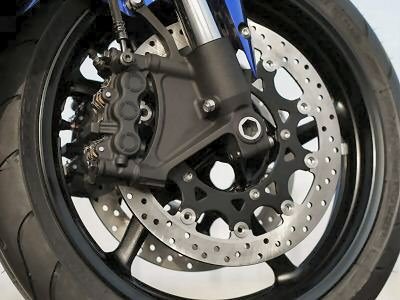Braking: Exercise One - Smoothness
 Exercise 1: Smoothness
Exercise 1: Smoothness
The intention of this exercise is smoothness. It focusses on being smooth with the lever, rather than finding the limit of its awesome power. So don't bother with extreme squeezing. At least for now.
What you do is find a deserted piece of clean tarmac and get all your safety kit on. That's EVERYTHING - I wear boots, riding pants, jacket, gloves and helmet - whenever I do any riding. Especially if I am practising skills.
Now, get up to about 60 kph and roll of the throttle. You want to brake smoothly to a stop. Initiate braking with a gentle (very gentle) dab on the rear brake. The dab should just get the front suspension collapsing and the weight transferring forward (you should feel this as a lowering of the front end and more weight on your arms). Once the weight has started transferring forward, you want to start using the front brake and release the rear brake until only a very, very tiny amount of rear brake is on.
The crucial thing to remember is to not use the brake faster than the weight transfer. As in, the application should not cause the suspension to dive noticeably further. Just before stopping, you will try to ease the rear brake back on and release the front brake progressively. If you do it right, your front suspension should depress progressively. There should not be any sudden or drastic change in the amount by which the stanchions disappear into the fork bottoms.
If you're pogo-ing the suspension, you're trying to hard. This exercise is about smoothness, not braking distance. So don't worry about how far you're going before you need to stop.
What you want to focus on is feeling the weight building up in the front fork. And then matching that build up with pressure on the lever. Tip: Move your hand like it is in slow motion through out the exercise - as in roll on the throttle slowly, get on the front brake slowly and ease of slowly as well. Go slow. The front disc can build force so quickly, and with so little movement, that you don't really need fast fingers for fast stops. Remember, as Nick Ienatsch said in his book, 'fast bike, slow hands.'
Once you become good at keeping with weight transfer, you will want to experiment with changing the rate of weight transfer and then keeping up with it. In this case, do use the rear brake to start the weight moving forward, but do not, repeat, do not use the rear brake to change that rate. As the rear end of the bike gets lighter (weight moves forward) it becomes easier to lock the rear wheel (which is why, in the middle of the braking process, we avoid the rear brake as far as possible).





















No comments:
Post a Comment